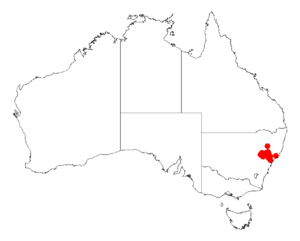Grub-pod wattle facts for kids
Quick facts for kids Grub-pod wattle |
|
|---|---|
| Scientific classification | |
| Genus: |
Acacia
|
| Species: |
piligera
|
 |
|
| Occurrence data from AVH | |
Acacia piligera, also known as the grub-pod wattle, is a type of tree or shrub. It belongs to a large group of plants called Acacia and is found naturally in eastern Australia.
What Does the Grub-Pod Wattle Look Like?
This shrub usually grows to be about 1.5 to 2 metres (4.9 to 6.6 ft) tall. It has an open, cone-like shape. Its branches stand up straight and then curve upwards. The smaller branches are either smooth (which means glabrous) or have only a few hairs.
The leaves of the grub-pod wattle are special. They are called phyllodes and are grey-green to green in color. These phyllodes spread out widely and are twisted on the branches. They are shaped like a wide oval or a wide, inverted egg. Each phyllode is about 12 to 22 mm (0.47 to 0.87 in) long and 6 to 15 mm (0.24 to 0.59 in) wide.
This plant can flower at different times throughout the year. When it flowers, it produces round flower clusters called inflorescences. These flower-heads are like small balls, about 8 to 9 mm (0.31 to 0.35 in) across. Each one holds 20 to 32 yellow or deep yellow flowers. After the flowers, the plant grows dull, dark brown seed pods. These pods are either oblong or curved and are about 35 to 80 mm (1.4 to 3.1 in) long and 16 to 20 mm (0.63 to 0.79 in) wide.
What's in a Name?
The grub-pod wattle can sometimes be confused with other similar plants, like Acacia uncinata or Acacia sertiformis.
The second part of its scientific name, piligera, is called the specific epithet. Scientists think this name refers to how the shrub looks a bit "downy" or slightly hairy.
Where Does the Grub-Pod Wattle Grow?
The grub-pod wattle is endemic to eastern New South Wales in Australia. This means it only grows naturally in this specific area. You can find it from the Hunter Valley in the north down to the Hunter Range in the south.
It likes to grow in stony, sandy soils that come from sandstone. It is often found in woodland areas.

